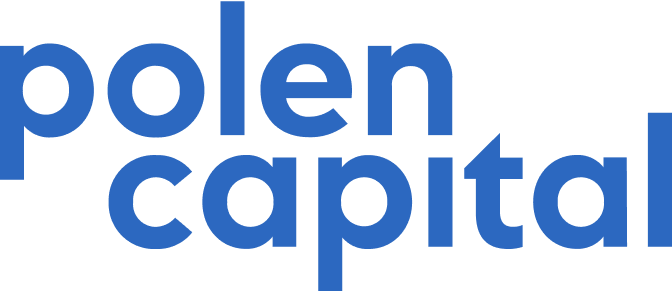Performance
| Qtr | YTD | 1 Yr | 3 Yr | 5 Yr | 10 Yr | Inception | |
|---|---|---|---|---|---|---|---|
| Polen International Growth (Gross) | 4.86 | 4.86 | 18.72 | 1.33 | 5.68 | - | 9.35 |
| Polen International Growth (Net) | 4.55 | 4.55 | 17.30 | 0.32 | 4.75 | - | 8.40 |
| MSCI ACWI ex USA | 4.69 | 4.69 | 13.26 | 1.94 | 5.96 | - | 6.77 |
Data shown (%) as of recent calendar quarter end. The performance data quoted represents past performance and does not guarantee future results. Current performance may be lower or higher. Periods over one year are annualized. Performance figures are presented gross and net of fees and have been calculated after the deduction of all transaction costs and commissions and include the reinvestment of all income.
| Polen International Growth (Net) | MSCI ACWI ex USA Index | |
|---|---|---|
| Alpha | 2.11 | - |
| Beta | 0.91 | 1.00 |
| Sharpe Ratio | 0.39 | 0.31 |
| Upside Capture | 99.21% | - |
| Downside Capture | 92.76% | - |
| Information Ratio | 0.19 | - |
| Standard Deviation | 16.63% | 15.83% |
Portfolio
| ICON PLC | 11.93 |
|---|---|
| Sage Group PLC/The | 9.58 |
| SAP SE | 7.82 |
| Aon PLC | 6.35 |
| Siemens Healthineers AG | 6.31 |
| Evolution AB | 5.32 |
| Medtronic PLC | 5.12 |
| ASML Holding NV | 3.87 |
| Shopify Inc | 3.69 |
| adidas AG | 3.45 |
| Total | 63.44 |
| Weighted Average Market Cap | $96.60B |
|---|---|
| Polen Long Term EPS Growth Estimate | 16.30% |
| Net Debt/FCF ex lease | 2.20% |
| P/E Forward (12m) | 24.50x |
| Return on Invested Capital ex Cash | 20.60% |
| Active Share | 89.90% |
| Annual Turnover (Since Inception) | 12.30% |
In an effort to avoid distorting aggregate portfolio characteristics, the weighted average portfolio calculations exclude an individual financial ratio that has a negative denominator or an outlier value (e.g., greater than 100x or 100%, less than 0%) which we view as not representative of the ongoing underlying economics of the business, likely due to transitory issues or GAAP accounting limitations. Additional information is available upon request.
As of 03-31-2024
| Information Technology | 32.95 |
|---|---|
| Health Care | 26.52 |
| Consumer Discretionary | 15.32 |
| Financials | 9.05 |
| Industrials | 8.48 |
| Consumer Staples | 1.87 |
| Cash | 5.81 |
Materials
Literature
Regulatory Documents
Polen Capital Management, LLC is an independent registered investment advisor.
Polen Capital claims compliance with the Global Investment Performance Standards (GIPS). This presentation is supplemental information to the fully compliant GIPS Composite Report performance disclosure on the Materials tab.
All performance is calculated in U.S. Dollars. Past performance is not indicative of future results. Returns are presented gross and net of management fees and have been calculated after the deduction of all transaction costs and commissions, and include the reinvestment of all income.
The MSCI ACWI ex USA Index is a market capitalization weighted equity index that measures the performance of large and mid-cap segments across developed and emerging market countries (excluding the U.S). The index is maintained by Morgan Stanley Capital International. The volatility and other material characteristics of the indices referenced may be materially different from the performance achieved by an individual investor. In addition, an investor’s holdings may be materially different from those within the index. Indices are unmanaged and one cannot invest directly in an index.
Holdings are subject to change. The top holdings, as well as other data, are as of the period indicated and should not be considered a recommendation to purchase, hold, or sell any particular security. There is no assurance that any of the securities noted will remain in a portfolio at the time you receive this fact sheet. Actual holding and percentage allocation in individual client portfolios may vary and are subject to change. It should not be assumed that any of the holdings discussed were or will prove to be profitable or that the investment recommendations or decisions we make in the future will be profitable. A list of all securities held in this portfolio in the prior year is available upon request.
Portfolio characteristics are shown as of recent calendar quarter end. There can be no guarantee that the portfolio will exhibit identical or similar characteristics to those shown at any future time of investment. Investments are subject to risks, including the possibility that the value of any investment (and income derived thereof (if any)) can increase, decrease, or in some cases, be entirely lost and investors may not get back the amount originally invested. This document does not identify all the risks (direct or indirect) or other considerations which might be material to you when entering any financial transaction. The views and strategi es described may not be suitable for all clients.
ESG refers to Environmental, Social, and Governance criteria. The International Small Company Growth strategy integrates material environmental, social, and governance (ESG) factors into research analysis as part of a comprehensive evaluation of a company’s long-term financial sustainability. There is a risk that the investment techniques and risk analyses applied, including but not limited to the integration of ESG factors into the research analysis, will not produce the desired results and that legislative, regulatory, or tax developments may affect the investment techniques available. There is no guarantee that the investment objective will be achieved.
Alpha: is the excess return of an investment relative to the return of the benchmark.
Beta: the measure of systemic risk of a portfolio in comparison to the market as a whole.
Downside Capture: is a statistical measure of overall performance relative to a benchmark during declining markets.
Information Ratio: a measurement of portfolio returns relative to a given benchmark.
Sharpe Ratio: a ratio of the return on an investment relative to its risk.
Standard Deviation: measurement of the dispersion or volatility of investment returns relative to its mean or average.
Upside Capture: is a statistical measure of overall performance relative to a benchmark during rising markets.
Active Share: Active share is a measure of the percentage of stock holdings in a manager’s portfolio that differ from the benchmark index.
Annual Turnover: percentage of the portfolio's holdings that have been replaced in a given year.
GICS Sectors: The Global Industry Classification Standard (GICS) is a system for categorizing every public company by economic sector and industry group.
Net Debt / FCF ex lease: a measure of a company’s ability to pay its obligations with free cash flow excluding leases.
P/E Forward: denotes the weighted harmonic average of all the P/E’s of the securities in the fund’s portfolio.
Polen Long Term EPS Growth Estimate: a Polen Capital estimate of projected long-term earnings growth rates (Earnings Growth is not a measure of future performance).
Total Debt/ Total Capital: measures the total amount of outstanding company debt as a percentage of the firm’s total capitalization.
Return on Invested Capital ex Cash: assesses an investee company’s efficiency at allocating the capital and is measured by operating profit after taxes divided by investment capital excluding cash.
Risk-Adjusted Return: a calculation of the profit or potential profit from an investment that considers the degree of risk that must be accepted in order to achieve it. Sharpe Ratio: a ratio of the return on an investment relative to its risk.
Weighted Average Market Cap: a weighted average of the price of each security multiplied by the number of shares outstanding all the securities in the portfolio.



